Release Date: December 12th, 1938
Series: Merrie Melodies
Director: Tex Avery
Story: Dave Monahan
Animation: Virgil Ross
Musical Direction: Carl Stalling
Starring: Mel Blanc (Daffy, I.M. Stupendous, Assistants, Sound Manager, Rooster, Chef, Lion, Boxing Announcer, Von Hamburger whooping), Rolfe Sedan (Von Hamburger), Jim Bannon (Newsreel Narrator), Sara Berner (Hen, Circus Lady)
Tex bids both 1938 and Daffy a close in his final cartoon with his own creation. Having progressed past the need for screwball characters, more focused on the straightforward, controlled approach, Tex revisits old gags and sensibilities that have been dropped for a year now.Not to be confused with Hollywood Daffy, Daffy Duck in Hollywood stars Daffy as a heckler wishing to break into the film industry. When he's promptly escorted via a trashcan to the face, he opts to disrupt filming on set and make his own movie himself, which proves as disastrous as it sounds.
Interestingly, the title card is not a new commodity. Rather, it was repurposed from A Star is Hatched, an abundance of neon lights replacing the waving spotlights in the latter. The title cue of "You Oughta Be in Pictures" foreshadows the breakout Daffy (and Porky) cartoon not even 2 years later from 1940.
Iris in on a facetious tagline that, ironically, various cartoon studios would use for years: WONDER PICTURES -- If It's a Good Picture, It's a WONDER.
Frank Tashlin would use it in his cartoon A Hollywood Detour during his tenure at Columbia Screen Gems (a motto which did indeed apply to the studio), albeit changing "wonder" to "miracle". Bob Clampett would do the same for his own It's a Grand Old Nag at Republic Pictures, following Tashlin's "miracle" outfitting.
Dissolve to the exterior of the producer's office. The name "I.M. Stupendous" is full of that signature Avery subtlety.
A shaky truck-in and dissolve wipes to Mr. Stupendous himself, animated by Irv Spence. Stupendous' pompous blue suit and carnation corsage is a friendly yet deliberate jab at studio head Leon Schlesinger, infamous for his own imperious suits and boutonnieres, an expensive contrast to the admittedly rickety and cheap architecture of the studio's own building.
Here, Stupendous' humming and satisfied glances at a stack of paperwork indicate the audience that he is invested in very, very serious matters.
A handful of quick, sharp knocks at the door causes him to disengage from his busy work schedule. "Come in?"
Daffy practically bulldozes the door down, pushing it open with both hands and running straight forward as he charges. In each and every Tex Avery Daffy cartoon, he takes on a new appearance. Here, he's closest to a finalized version yet, the blue irises and neck ring from Daffy Duck & Egghead absent. Instead, he's simultaneously bulbous yet scrawny, a nub (and three hairs) on his head rendering him screwy by his design alone.
"Say, fella! D'ya need a good duck actor?" As is always the case, Spence's animation is rife with appeal and energy. Daffy is a good vessel for his spastic-n-elastic animation style.
A "WOOHOO!" conveys Daffy's enthusiasm succinctly, if his barging in and shrill voice wasn't enough.
No time is wasted as Stupendous bellows "NO!" and sends Daffy flying out the door* via wastebasket. *Daffy doesn't actually fly out the door--his cel slides across the screen, not accounting for the doorframe, and instead slides right past the wall. Regardless, the message is clear.
Already, Avery's pacing is on the faster side. Pauses are scarce, and Stupendous immediately turns to the audience, remarking "that duck's screwy!" Like the ending of Daffy Duck & Egghead with the ambulance driver duck evaluating Daffy's sanity, Stupendous keeps his voice low, as if Daffy will somehow overhear his assessment and take offense.
But, as stressed in the previous review of The Daffy Doc, Avery's duck takes everything in stride. His feelings are seldom hurt, and whereas Bob Clampett's duck would have rejected his ejection (as proved in Doc), Avery's duck reassures that there are no hard feelings. He does so by emerging from Stupendous' ringing telephone, shrieking "YOU'RE CORRECT! AB-SO-LUTELY CORRECT!"
No Avery Daffy cartoon is complete without the nose honking. Wonderfully appealing and loose drawings from Spence as Daffy shrieks and whoops his way out the door, now on his own volition. Rather than insisting he be hired or make Stupendous chase him around to get him out, he decides to leave on his own accord.
Seeing as he can't yell at Daffy to get out of his office, Stupendous instead opts to carry about business like usual, snagging the telephone. He requests that a "Miss Morgan" get director Von Hamburger on the line; Miss Morgan is yet another inside joke with the studio, in that Ginger Morgan was the name of one of WB's studio secretaries.
"Hello, Von Hamburger?"
"Yes sirrrrrr!" Von Hamburger is voiced by actor Rolfe Sedan. Every time he utters a word with the letter "r" in it--quite often--he rolls it in a ridiculously pompous manner. It's amusing, and effectively annoying. Between Sedan and Berneice Hansell's squeaky vocals in Avery's cartoons, he loved testing the limits of his audience by seeing how long they can withstand purposefully annoying voices or gags.
The next gag, however, is most certainly not annoying, but clever and clear. As Stupendous and Hamburger converse on the phone, the camera seamlessly trucks out to reveal both of them at either end of the desk, talking through the phones. Their conversation continues like normal, as calling too much attention to the ridiculousness of the joke would ruin it. Therein lies the genius of Tex Avery.
Stupendous demands that Hamburger complete his film by the end of the day or else. Hamburger, a portly pig dressed in stereotypical magisterial director's garb, reassures him with vibrating "Yes sirrrrrr!" His beret thrashes violently atop his head with each "r".
"I'll rrrrrrush it thrrrrough rrrrrrrrrrrrrrrrrrright away!"
Interestingly, the layout between the two scenes is wildly inconsistent. In the scenes with Daffy and Stupendous, wood paneling adorns the back wall of office, as well as portraits of clients. The scene with Stupendous and Hamburger, there's suddenly a window replacing the headshots prior, and the desk is much closer to the wall. Stupendous is still shot facing the door--otherwise, the audience would realize that something was fishy with the staging and that a gag was lurking in the shadows. Regardless, the gag is incredibly clever and the composition is crucial to its success. The characters and opposite staging is the priority, not whether or not there's a window on the rightmost wall.
In any case, "goodbye"s are exchanged as we segue to the next scene via a fade out and in. Cleverly, Avery adds a bit of tongue-in-cheek commentary not only with the neon lights flashing "DIRECTOR" on the back of Hamburger's chair, but having the neon lights be the first thing we see as the fade comes up. Stressing Hamburger's egotism is crucial. It's Hollywood, after all.
Hamburger displays his talent as a director by getting down to business, pontificating that whatever scene he's working on needs a close-up. "Am I rrrrrright, boys?"
Another unsubtle jab at Hollywood as Hamburger's "boys" swarm around their beloved director in an instant. Synchronized, clique-like nods are given as they chant in unison: "Yessir! Yessir! Yessir! Yes SIR!" Carl Stalling's music score of "Gee, But You're Swell" seems to reflect their opinion on their esteemed boss.
And, just as quickly as they crowded around him, they disperse in eerie unison. A job well done.
With that out of the way, Hamburger indulges himself in a smoke break. Digging inside his pockets, he unearths a shiny, expensive cigarette case. Only the finest of carcinogens for him.
Cue the inevitable Avery bait-n-switch as the cigarette holder is revealed to hold gently used cigarette butts. With Avery's gag sense becoming more and more refined, moments such as these could easily be found in one of his M-G-M cartoons (with twice the speed.)
The dainty, ginger manner in which Hamburger removes one of the butts makes the gag all the more amusing. Just a routine piece of business for him.
Hamburger doesn't even attempt to fish a lighter from his pockets. As soon as he stuffs the half-consumed cigarette in his mouth, his lackeys all approach him with matchsticks. The nonchalant, bored expression on Hamburger's face informs the audience that this is a regular occurrence.
As such, a roaring fire erupts from the shared matchsticks. Avery's sense of humor and direction weren't so much the screwball type anymore, justifying his disposal of Daffy after this. Playing absurd scenarios in icy cool deliveries is more his way to go. Consequently, there are no histrionics as Hamburger gets singed from the dangerous fire centimeters from his face, no shrieking or screaming or backhand springs as turns into a pork roast. Instead, he remains frozen in place, the nonchalance another joke in itself.
The reversals don't stop there. With that piece of business rightly attended to, the fire burns out. Interestingly, the last held cel of the scene has a double exposure mistake, rendering a few lackeys transparent and ghostlike.
Now does Hamburger suck on his cigarette like a baby sucking on a bottle, pathetically trying to get at least a little puff.
Desperate times call for desperate measures: light your own smoke yourself.
Enter the ever popular Avery convention of mixing standard with impractical, antiquated with modern. In this case, the humor is almost regressive, harkening back to the early days of the Harman and Ising era. A flick of the lighter prompts a matchstick to pop out of the hole, and a dainty finger extending from the cover.
All is well. Carcinogens are free to be sucked on and inhaled.
Yet, seeing as this is Daffy Duck in Hollywood and not Von Hamburger in Hollywood, the star waterfowl lives by Avery's conventions that his entrances should be as inopportune as possible. While Hamburger leisurely puffs away on his cigarette, Daffy happily indulges in that age old mantra: what's yours is mine, and what's mine is also mine.
If huffing on Hamburger's pilfered cigarette wasn't enough of an insult, Daffy expresses his condolences with--you guessed it--a honk on the snout.
Porky's Duck Hunt and Daffy Duck & Egghead had Daffy's hysterics being conveyed through a de facto water ballet of sorts, cavorting and skipping through the pond. Here, Daffy's romp is accessorized by a healthy plume of cigarette smoke. Too busy sucking in the tobacco, he doesn't whoop and holler, but instead gets to work, writing "WARNER BROS." in a plume of smoke.
Much to the success of the scene, the animation of the smoke is surprisingly sophisticated (could this perhaps be another instance of A.C. Gamer doing both effects and character animation?) and realistic--a vague, lumpy, cloudlike mass of smoke would tarnish the joke and read as childish.
"Huh-huh! Just givin' my bosses a plug! Ha!" Daffy looks and sounds maniacal, proudly holding his stolen cigarette as he explains himself. The fact that he's perched atop a soapbox is duly noted. "I've got an option comin' up!"
Gymnastics resume, along with gleeful whoops.
Once more, Avery doesn't necessarily linger on the consequences of Daffy's actions. There's no frustrated reaction from Von Hamburger, no snide remarks--he instead moves onto the next piece of directorial business. "How's the sound?"
The sound man is a dog-shaped ball of Irv Spence goodness, with snappy, elastic movements and appealing design sense (look at all those wrinkles!) He gives the director the okay with a spirited "Okey-dokey, chiefy!"
Segue to Daffy's heckling sabotage. Avery's duck is purely a vehicle for gags and mayhem. Here, he clings to a nearby microphone, whistling directly into it to spark ferocious feedback. The sound is successfully excruciating, another indicator of Avery's adoration with testing the audience's limits. In his M-G-M cartoon One Ham's Family, the star of the film scratch nails on a chalkboard ("I might as well heckle you people out there!") and it is as painful as it sounds. Daffy's own sound-based heckling here serves as a precursor.
Poor Irv Spence dog is assailed by the noise, prompting him to do a rather comic strip inspired flop take. The take is a little forceful, feeling like a voluntary, controlled switch between two poses rather than a spontaneous act of flopping, but that doesn't at all negate the integrity of the drawings, which are wonderfully dynamic and energetic.
On the topic of M-G-M precursors, Daffy feels particularly reminiscent to Avery's Screwy Squirrel in such scenes. The gags themselves are the topic of conversation, not necessarily the reactions. Whereas Screwy seems to get a thrill out of heckling his victims and driving them crazy, Daffy seems to heckle purely for the fun of it, reception be damned. In his next bit of business of flexible cartoon logic, he hooks a nearby fire hose up to the light control box.
And, when lights are called, copious amounts of water are dumped on the stars of the film (who are introduced rather abruptly.) The staging is clever, particularly with Von Hamburger's silhouette front and center, pumping his fists and declaring "It's rrrrrrrrruined!" Love the silhouette of the beret flopping around with each roll of the r.
Avery continues to throw one gag after the other with very little breathing room and no focus on the reactions of the bystanders. In this case, Daffy's heckling turns incidentally murderous as he loads a camera with bullets rather than a filmstrip. The grin on his face as he happily dumps the murder weapons into the camera is pretty amusing.
More amusing than the bullets spitting out of the camera as its rolled is that classic Avery nonchalance. No exclamation of "THERE'S BULLETS IN HERE!" or even a dubious blink at the camera. Instead, the cameraman continues to crank the camera without a second thought. While Avery's gags aren't uproariously hilarious here, they are at least aided by their straightforward and inconspicuous deliveries. That, in turn, makes them all the more absurd.
In any case, Von Hamburger has finally hit his limit, erupting in tears. Rather than sobbing about the damage from the bullets (or potential lawsuits), he instead garbles one of the funniest lines from the cartoon: "THIS ISN'T A GANGSTERRRRRR PICTURRRRRRRRRE!"
Virgil Ross animates Hamburger's meltdown, kicking his legs and sniveling like a toddler. In a moment that is rare in the Avery cartoons, Daffy expresses his condolences, actually displaying a shred of self awareness.
"Take it easy, skipper!" Daffy has now called 2 different pigs "skipper" in 2 different Avery cartoons. "I'm sorry. I won't be screwy anymore."
If there was any doubt to his loyalty, he solidifies his promises with "Cross my heart!"
Von Hamburger perks up immediately, all the more reason to be excited as Daffy hands him a present to make up for his behavior. Stalling's facetiously saccharine, tear-jerking violin accompaniment is a nice piece of sardonic pathos.
As Daffy contentedly struts away, Hamburger eagerly unties his present. Between that and the sobbing, sniveling tantrum, he seems like an overgrown child, always amusing when portrayed by people in positions of power. He dares to peek inside...
HONK!
Daffy gleefully recites his earlier mantra of "It's me again!" from Porky's Duck Hunt, as if that wasn't clear enough.
Fade out as a nonplussed Hamburger observes Daffy's hysterical ballet once more.
Cut to a more relaxed and theatrical scene (both figuratively and literally), silhouettes of the crew framing the actors as they strut onto set. There's a particularly nice bit of cinematography from Avery as the camera trucks into the scene, past the moving silhouette of Hamburger who declares "ACTION!"
Daffy Duck in Hollywood is regressive in a number of ways, but that's not entirely a bad thing. For instance, Avery revisits his fixation on Katharine Hepburn caricatures, not visited by him in over a year. A purposefully mawkish score of "The Kiss Waltz" accompanies the poultry romance unfolding on-screen. The costumes, the acting, and the background all clue the audience in that this is a sickeningly trite production. This is Von Hamburger's pride and joy?
Avery indulges in his Hepburn-isms, one of the standout lines being the hen's oxymoronic claims of feeling "so sadly happy." (Rah-lly, it does.)
Playing the scene straight is, again, crucial to its success. Avery purposefully makes the production sickeningly sweet and borderline unbearable, and he sticks to his guns. Even in Little Red Walking Hood, when Red (also a Hepburn caricature) and the wolf go through the entire "my, what big ___ you have" shtick, Red halts the performance to coo "Rather childish and a bit silly, don't you think?"
Here, there are no tongue-in-cheek asides. The tongue-in-cheek aside is the performance itself. Avery's conviction to playing it straight is what makes it so funny and agonizing at the same time. Already, the audience is bracing--and hoping--for an interruption.
After sappy monologuing from the Blanc rooster, the Sara Berner hen gets to the goods. "Oh, kiss me, my sweet... kiss me..."
It is law that Hollywood kisses must have an atmospheric pause before them. The cloying music score crescendos...
...and Daffy happily obliges to the demands of the script. It's worth mentioning that a more cognizant and "mature" Daffy would do the same thing in Frank Tashlin's The Stupid Cupid--always one for the ladies.
With that, the music score turns more upbeat as Daffy shrieks to the audience, now repeating some words of wisdom from Daffy Duck & Egghead: "Wotta kiss! WAOW! I think I'll do it again!"
And that he does, heel-clicking and "WAHOO!"ing all around the set before diving off-screen.
More loose-limbed animation from Spence, a refreshing change of pace from Paul Smith's rather straightforward and serviceable animation from the scene prior. Now, Hamburger once again despairs that "IT'S RRRRRRRRRRUINED!"
"CUUUUUUUT!"
His abrupt change in demeanor as he throws himself in his chair and coyly asks "What time is it, boys?", fluttering his eyelashes, is wonderfully timed and executed. A coquettish reprisal of "You Oughta Be in Pictures" reflects the dainty mood change.
Once more, his lackeys swarm the area, all shoving various clocks in his face. The misaligned chorus of ticks is a hilarious reflection of their boot-licking servitude, stressing just how ridiculous their subjugation is. Together, they chirp in eerie unison, "Twelve o'clock, sir!"
Their exit is incredibly brief, a joke in itself. Hamburger seems pleased.
"I'll take turrrrrkey wit' all der trrrrrrrrrrrrrrrrrrrrrrrrrrimmings!"
No time is wasted as a chef lumbers into the studio, lifting the lid on the platter to reveal the trrrrrimmed turrrrrkey.
Eager to indulge, Von Hamburger wastes little time in preparing to eat.
Shocker! Seems roast duck is on the menu instead. Nice perspective on Hamburger with the slight head tilt. It's hard to see because it's so small, but you can even see Daffy sticking his tongue out as he plays dead.
More nose honking ensues, as well as hysterics. Daffy's laughter is hysterical in more ways than one--that, paired with the frenzied animation of him skipping and writhing around the lid, makes for a much more rewarding ballet de screwball. The exit he makes after honking Hamburger on the snout a second time is priceless, purposefully defying all laws of physics.
Now, Daffy's hysterics take him to the outside of the next door film library. Judging by his slight pause and subsequent skipping to the front door, trouble seems imminent.
Daffy's off-screen body seems huge in comparison to his tiny head. He looks positively ugly and unappealing, but one almost senses that that was the objective, appearing scrawny and wily and ready to cause mayhem. The Bob Clampett philosophy of "crazy, sadistic creatures must be unassumingly cute to be extra funny" does not apply to Tex Avery.
Thrilled by the film cans stacked wall to wall in the library, Daffy shrieks another "WAOW!" as he pumps his fist, peering at the audience with his beady eyes. "I'll give 'em a REAL feature! WOOHOO!"
Tex Avery flexes his own cinematographic muscles in a playful, cinematic, and dynamic montage of Daffy cobbling together his own film. While Avery's humor is indeed an important factor in the notoriety of his cartoons and legacy, his cinematography--that is, composition, staging, camera angles, and the like--is relatively overlooked. Sequences such as these make a strong case for his success as a director, almost rivaling Frank Tashlin's own keen eye for theatrics.
Here, Stalling's music score of "You Oughta Be in Pictures" does all the talking, rising in a crescendo with anticipatory excitement with each cut. It's also worth noting that the film cans in the first shot are for Boy Meets Girl and The Adventures of Robin Hood, both films produced by Warner Bros. that year.
The montage comes to a close with a shot of Daffy winding up his film, the music score almost alarming and ominous, furthered by the fade to black. Surely no good will come out of this.
Meanwhile, a much happier Von Hamburger marches up to the desk of one I.M. Stupendous, promising that his film is rrrrrrrready to rrrrrrrun. He places the reel next to the desk for safe keeping.
Or, not so much. Daffy takes on a rather Droopy-esque quality in that he can pop up at any place at any time and nobody can stop him. Here, he at least tries to act sneaky, quietly swapping out Hamburger's reel with his own. The details on the film reel, specifically the lines indicating the layers of film strip, are meticulously drawn and inked. Having to keep every single line consistent sounds like a nightmare.
With that, Stupendous and Hamburger head on down to the projection room to play the film. More "r" gags as Hamburger instructs the projectionist, "Rrrrrrrrrun 'dis forrrr us, Rrrrrrrrrrrrudolph!"
Stalling's music accompaniment is deceptively domestic, relaxed and wholesome. A lingering sense of playful dread looms in the pits of the audience's stomach. V.H. seems incredibly pleased with himself.
While Hollywood has been a relatively retrograde entry by Avery's standards, the concept of Daffy's film is shockingly ahead of its time and a shining moment of what makes Tex Avery so unique as a director. While not to spoil too much, the film is full of nonsensical cuts and splices with purposefully terrible filmmaking, making it rife with comedic potential. Comedy is derived from contrast and juxtaposition. Daffy's film embraces wildly polar attributes for the sake of humor--and the best part is that he believes he's doing a real service, not trying to be funny or purposefully screw things up. He just wanted to make a movie, and that he did.
Bizarrely, the title of the film, "Gold is Where You Find It", is verbatim the title of an actual film, released by Warner's in 1938.
Cut to live action footage of some workmen scored to a purposefully ill-fitting and pompous score of "The Ride of the Valkyries". Even more bizarre is Von Hamburger's reaction; he doesn't seem to notice that this isn't his film in the slightest, and instead balloons with self-congratulatory pride, his ego so big that the buttons on his shirt pop completely off.
Daffy's film is largely rooted in the structure of a (very contradictory) newsreel. The headline for the next segment advertises "New Arrival in Central Park Zoo", with a lion's face beneath the typography.
Cut to footage of a lion roaring. On top of the roars is a purposefully disjointed and monotone narration, trying to make it appear as though the lion is actually claiming "Motion pictures... are... your best... entertainment."
Perhaps more amusing than the gag is the knowledge that Avery would briefly dabble in the very entertainment he is making fun of after his stint at Warner Bros. Before heading off to M-G-M and after his departure at WB, Tex created a brief film series titled "Speaking of Animals", which is exactly what you see here: dubbing voices and dialogue overtop live action footage of animals. Thankfully, that venture didn't last too long. In any case, you can check out his work for yourself; he even uses Mel Blanc, Berneice Hansell, Sara Berner, and Kent Rogers among the voices, all Warner's alumni.
Back to the cartoon, it takes the disjointed talking lion for Hamburger to realize what's happened. He can hardly dare to believe it.
Next comes the typical "sunny California" gag that's been a part of the Warner stock gag library ever since Bosko's Picture Show. As the title card says, a narrator happily chirps about "happy legionnaires" passing in review.
Cue the direct opposite, some humor lingering in the antithetically chipper accompaniment of "California, Here I Come".
Tex seems to understand that the previous two gags are mildly amusing at best, and it's time to crank things up. As such, the next sequence spotlighting the test flight of a new aircraft has some edits made to it outside of narration. In accordance to the narrator's remark of "And he's off!", a WWI-era plane charges straight down the "runway"...
...and into a barn.
Here's where things get a little more advanced. After the plane crashes into the barn, the footage rewinds, going back forward again as the narrator once more chirps "...He's off!" The same also occurs for a third and final time. Comedy is done in threes.
Meanwhile, the footage of "hundreds of jitterbugs" engaging in a dance contest is instead footage of a dainty, stiff lipped ballroom dance. The raucous musical jazz accompaniment is a nice contrast to the formal atmosphere of the "contest".
We briefly cut back to Von Hamburger and Stupendous; Hamburger is cowering in his seat, sparing cautious glances at his producer. He knows he's dead meat.
Undoubtedly the greatest part of Daffy's film is the wrestling match, narration provided by a gravelly, snarling Mel Blanc.
Under normal circumstances, "Madison Round Garden" is a stupendously lame play on words. Here, it somehow manages to work because the boxing ring is so square. If there were any and all references to "Madison Square Garden" that needed to be tacked on, here would be its destination. As such, Avery purposefully dubs it as the complete opposite, more for the effect rather than the sake of the gag itself.
"And now the boys leap to the center of the ring." Said boys instead idly stand in front of each other, not moving a single muscle. In any case, Mel's narration grows more frenzied and spirited; "Here's what's-his-name giving so-and-so a terrific right to the jaw! And there's a hard right to the head! And another hard right! It's too brutal, I can't stand it! I CAN'T STAND IT!" The entire time, the wrestlers don't make a single move. Mel's narration sells the gag completely.
As the gags persist, the narration over the title cards drop, as Avery understands the momentum can't keep resetting itself with each new presentation. As such, the "bathing beauties" are subject to catcalls and breathless "Ba-by!"s from the narrator, as was typical towards anything remotely feminine in these cartoons. The narrator's exclamation of "Baby!" is synonymous with the same catcalls from Avery's Cinderella Meets Fella. Stalling's musical accompaniment of "Garden of the Moon" is a nice, romantic contrast to the sporty music score overtop the boxing match.
Unfortunately, the punchline is regrettably dehumanizing. The winner of the contest is a separate clip of a rather heavyset woman in a circus act taking a bow; Sara Berner's Hepburn-esque narration of "I'm happy all over. Thank you," is at least as amusing as it can be.
Thus ends Daffy's film. Avery loved messing with the very medium he excelled in. His Porky's Preview in 1941 is all about a child Porky presenting his animated cartoon, which is laughably childish and sloppy. In one of his first cartoons for M-G-M, The Blitz Wolf, the M-G-M lion's roar is spliced in a very similar fashion to Daffy's own film here, as if to say "Look out! Tex is here to stay!"
Admittedly, the concept of Daffy's film may indeed be more amusing than the content of the film itself, but it's easy to make that judgement having seen dozens of jokes in this manner that released after the fact. For the time, this was rather groundbreaking. It becomes all too easy to dismiss this as a line of tropes, but those tropes all had to start somewhere, and it was here that they did.
In any case, stoic, crotchety, pompous I.M. Stupendous is floored. Irv Spence's animation is the perfect accompaniment for Blanc's impassioned vocals, both voice actor and character actor incredibly energetic in their deliveries.
"Amazing!"
"Marvelous!"
"Stupendous! Colossal!"
"Tremendous! Gigantic! Astounding!"
"UNBELIEVABLE! SPECTACULAR!"
"PHENOMENAL!"
Stupendous' final topper of "...and it's good, too!" is not exclusive to Avery--in fact, the gag itself debuted for Warner's in Buddy's Theatre, of all places. In any case, this is no Buddy's Theatre and hopefully never will be Buddy's Theatre. Blanc's vocal deliveries, Spence's elastic, frantic energy, and Stalling's anticipatory, climactic music score all tie the joke together and indeed make it something spectacular, phenomenal, and even good, too.
Hamburger, on the other hand, has passed out from all the excitement. Spence's graphic design sensibilities are given a chance to shine in the stars and spirals accompanying V.H.'s daze, furthered by (what else?) Treg Brown's tweeting bird sounds.
Iris in to the studio's newest director. Miracle of miracles, his plan worked.
Happily chuffing on a cigar, Daffy orders a turrrrrrrkey with all the trrrrrrrrrimmings.
Rather than Hamburger's nonchalance towards his lackeys, Daffy seems proud to have his own crew of boot-lickers catering to his every whim. The idle bouncing of the foot is a nice detail.
Reusing footage from earlier, the chef enters once again with a trrrrimmed turrrrrkey on full display.
Irv Spence bookends the cartoon, having been the one to animate the first scene. Wonderfully appealing drawings as Daffy rubs his hands together, salivating at the thought of his meal.
A meal of fresh pork, that is. Von Hamburger now gets his comeuppance by biting Daffy's own beak in an act of retribution, the four car horn sound effect having been used since the Harman and Ising days.
Daffy appears slightly dazed and inconvenienced at most. Hamburger, meanwhile, is granted his own hysterical, whooping ballet, very similar to the ending in Daffy Duck & Egghead where Egghead too succumbed to the ways of the duck. Spence's drawings are always a treat to iris out on.
Daffy Duck in Hollywood is a fascinating cartoon in that it manages to be both behind and ahead of the times. It's exceedingly clear that Tex has evolved past his need for Daffy. No longer focused on screwball, zany characters and others reacting to said characters, Tex's sense of humor is more refined and straightforward, prioritizing absurdity played cool. Tex's Daffy, by design, is not meant to be played cool. As such, he reverts back to old habits and gags that he hasn't touched in nearly a year. Even some of the music choices seem regressive; "Gee, But You're Swell" was a popular tune in 1937 Warner cartoons, and hearing it again paired with these retrogressive gag structures almost feels like a time machine.
Meanwhile, Daffy's film, politely amusing as it may seem now, was once a breakthrough in Avery's humor and something he'd carry a torch for for years. One can even see the inklings of Avery's travelogues settling in with the spot gag nature of the homemade film, for better or worse.
Hollywood does lack the bite that Avery's previous string of films had, something even present in something as derogatory as Johnny Smith and Poker-Huntas. Regardless, it's still amusing, and Avery's cinematographic touches, whether it be something as strong as the montage of Daffy editing his film or something as subtle as a scene's composition, are not to be taken for granted. Avery sets a very high standard for himself, and "mildly amusing" for Avery still equates greatness comparatively.
It is lamentable that he dropped Daffy so quickly, but understandable. Comparing this Daffy to Bob Clampett's Daffy in The Daffy Doc, it's clear where the investment of the character now lies. Daffy speaks more to Clampett's screwball tendencies, and Avery doesn't seem too concerned about keeping the character afloat himself. To him, Daffy is a vehicle for gags who tests the audience's patience with his annoying antics. While I wish he revisited Daffy for another final outing towards the end of his WB tenure (as he did with Porky for Porky's Preview, a 4 year gap between appearances), I can understand why he'd want to shift focus. For Avery, he's served his dues.
Hollywood is still very much worth watching in spite of all its ups and downs. Irv Spence and Virgil Ross have some very nice scenes of animation, Blanc's voice acting is nothing short of hilarious (as are Rrrrrrrrolfe Sedan's deliverrrrrries), and Daffy's film is certainly worth a watch. 1938 was a wonderful year for Tex Avery, and probably consistently his best until 1941. The irony of his '38 filmography both starting and ending with Daffy is not taken for granted.


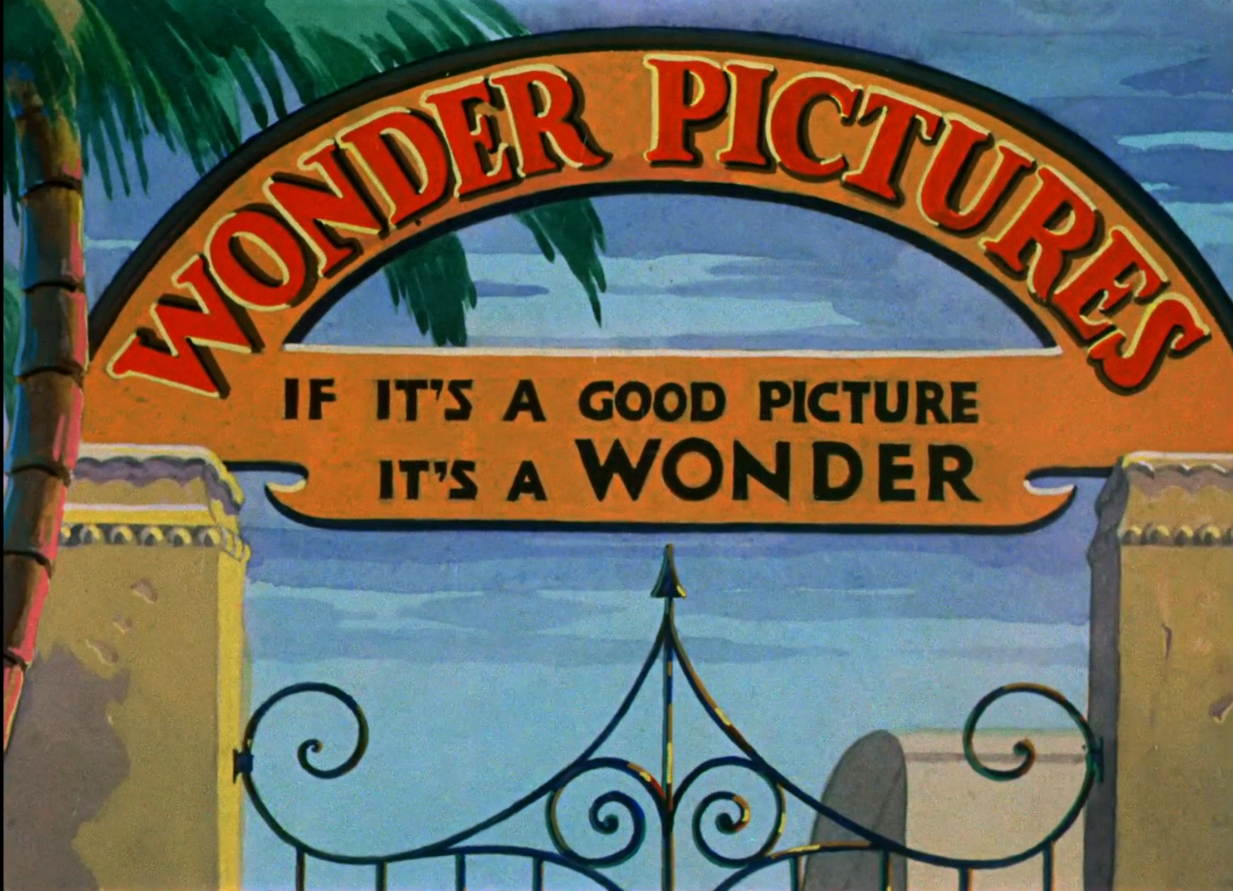




















































































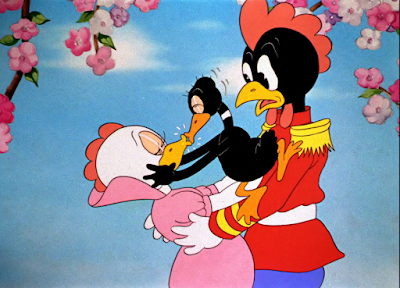
















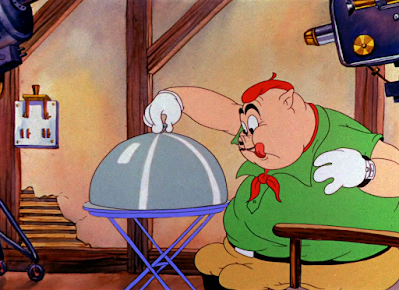


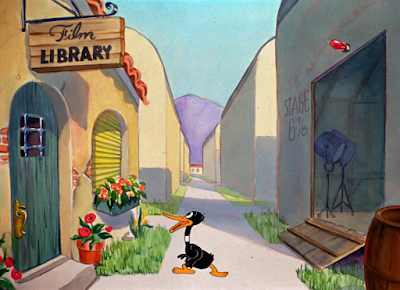



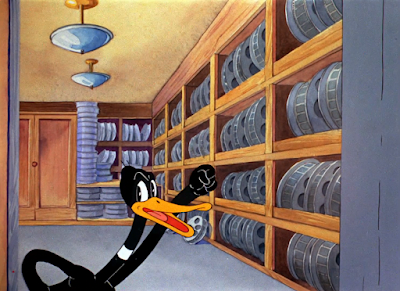




























































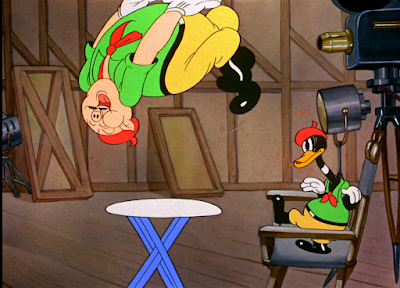







No comments:
Post a Comment